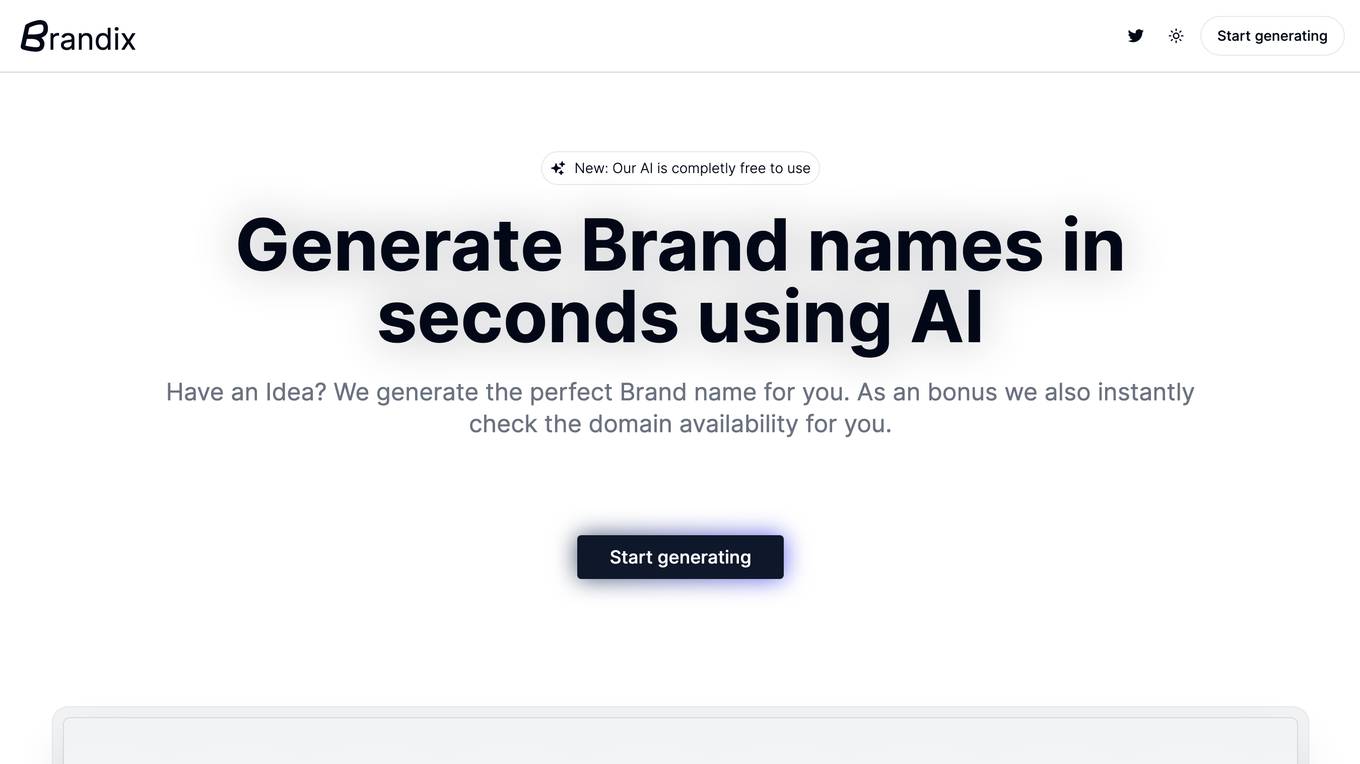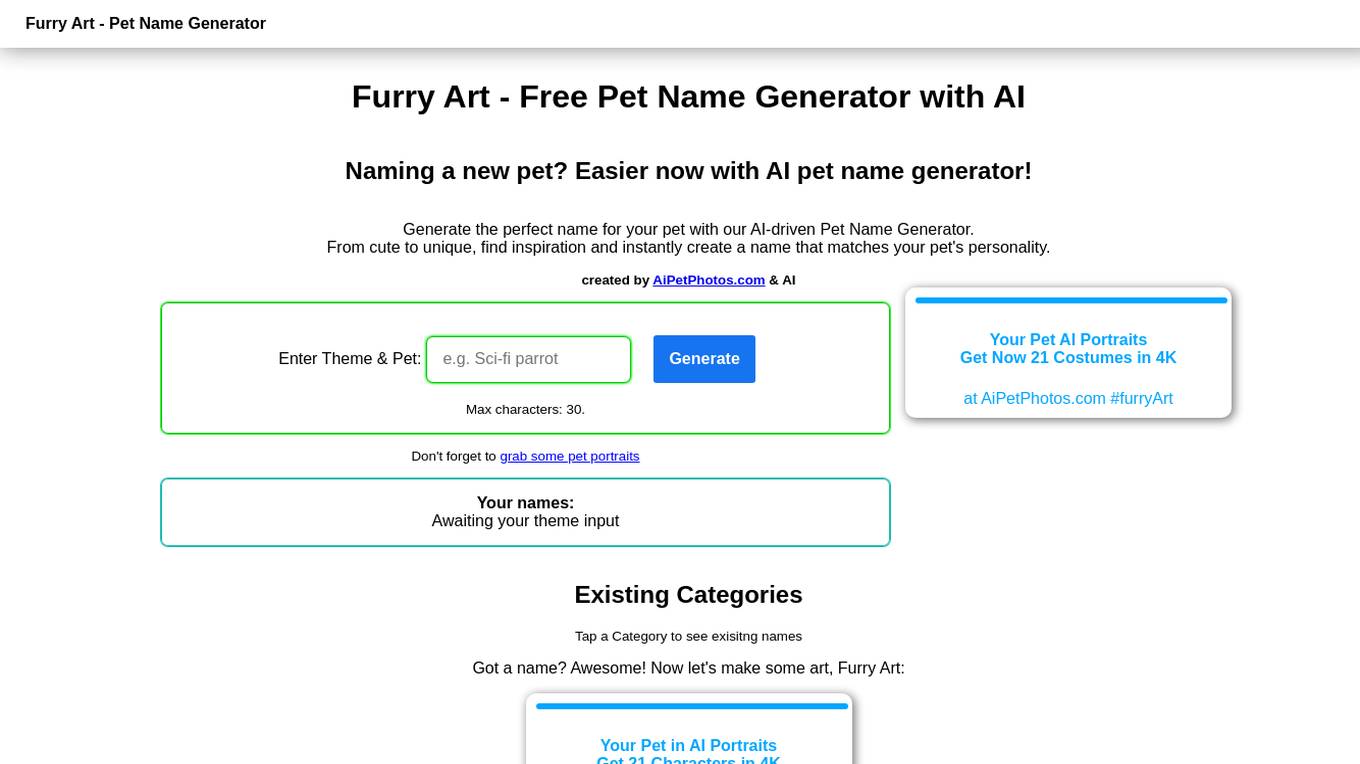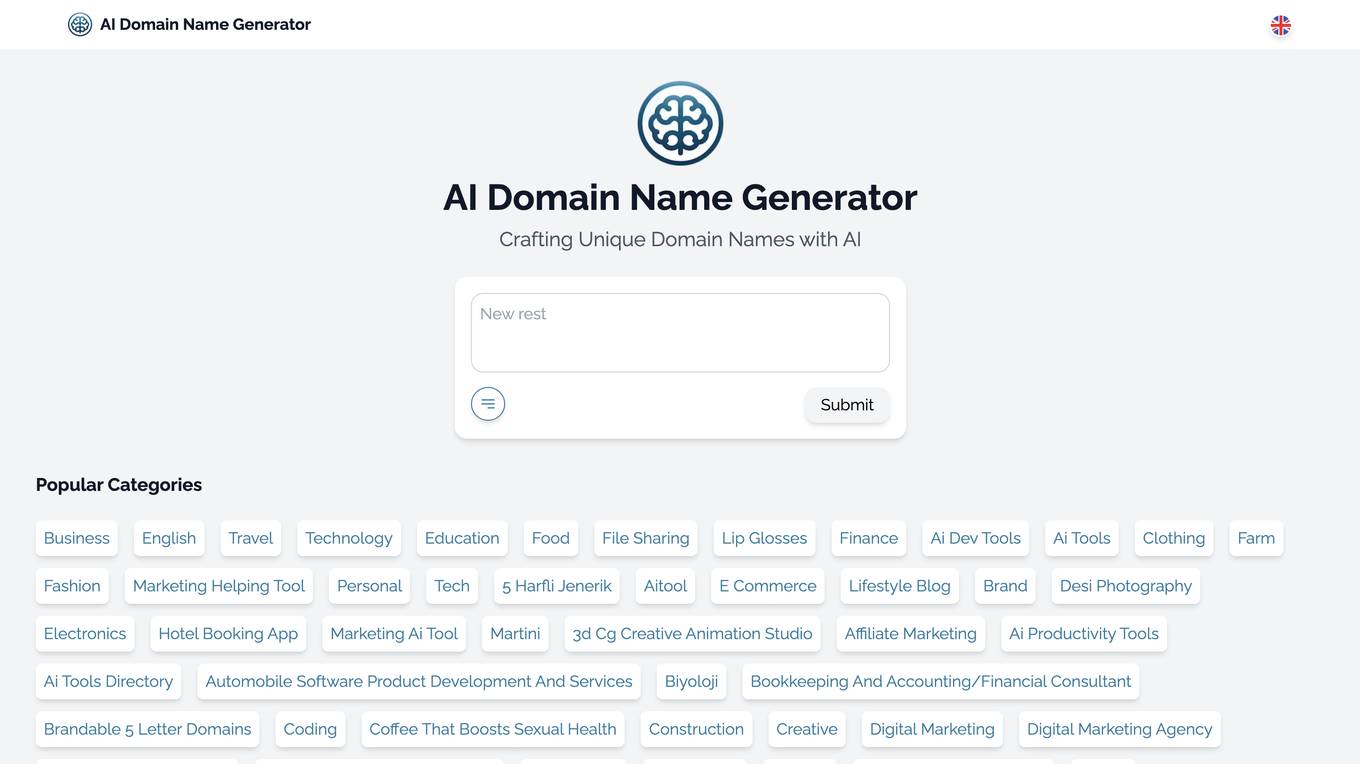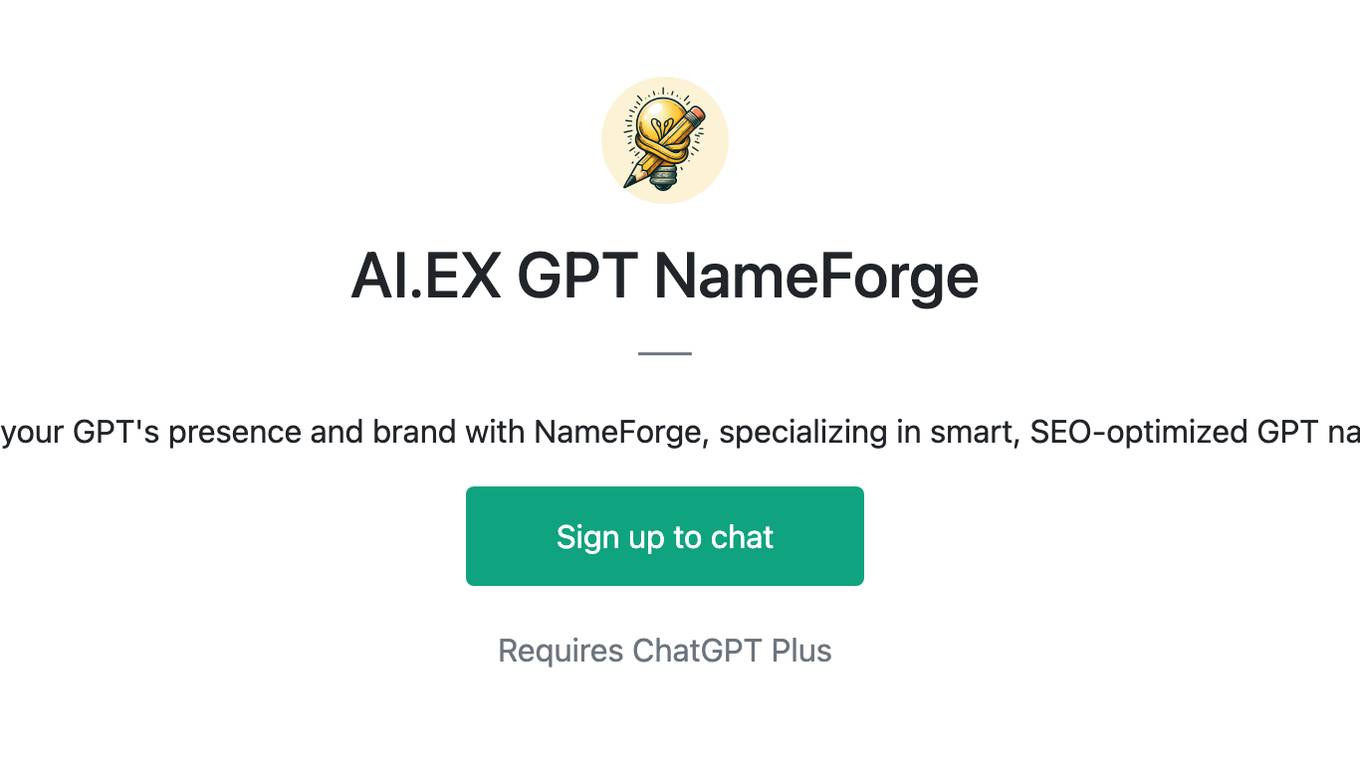Best AI tools for< Generate Names >
20 - AI tool Sites

AIwukong.art
AIwukong.art is an AI application that specializes in generating Chinese names and creating Black Myth Wukong style art. Users can generate ancient Chinese names, funny memes, and download fantasy wallpapers inspired by Black Myth: Wukong Collector's Edition. The website offers a unique blend of cultural elements and artistic creations, catering to users interested in Chinese culture and mythology.

NameSnack
NameSnack is a free business name generator that uses machine learning and other naming techniques to help entrepreneurs and business owners find unique and memorable names for their brands. It offers a variety of features, including industry-specific naming, instant domain search, and logo design. NameSnack is easy to use and can help you generate names for a variety of businesses, including startups, apps, shops, restaurants, podcasts, products, and more.

Brandix
Brandix is an AI-powered tool that helps users generate brand names quickly and effortlessly. By utilizing artificial intelligence technology, Brandix offers a seamless experience for individuals looking to create a unique and memorable brand identity. Users can input their ideas or choose from predefined categories to receive instant brand name suggestions. Additionally, Brandix provides domain availability checks as a bonus feature, streamlining the process of securing an online presence. With a user-friendly interface and a database of generated names, Brandix aims to assist entrepreneurs, startups, and businesses in finding the perfect brand name.

NamePepper
NamePepper is a free AI business name generator tool that helps users unlock brandable names for their businesses. The tool generates hundreds of creative and iconic business names tailored to the user's preferences and industry. Users can quickly check domain availability, save favorite names, and get feedback from others. NamePepper aims to simplify the naming process and save users time and effort in creating a memorable brand identity.

Pleasureye
Pleasureye is a powerful AI tool that offers a wide range of content generation services, including name generators, blog writing tools, ad copy generators, and more. It uses generative AI to provide high-quality suggestions and instant results for creating unique and engaging content within seconds. The user-friendly interface, customization options, diverse categories, and easy save and share features make it a convenient tool for individuals and businesses looking to enhance their content creation process.

NameBridge
NameBridge is an AI-powered tool that generates connotative Chinese names based on English names. The tool ensures the generated names sound great and have deep meanings. It is designed to help individuals create culturally appropriate Chinese names for various purposes such as business, writing, art, travel, and personal interests. NameBridge uses AI algorithms to instantly generate unique and meaningful Chinese names that are culturally significant and can be used in various contexts.

Name Generator
Name Generator is an AI Name Maker based on OpenAI ChatGPT that quickly generates various names like boy names, girl names, dog names, nicknames, fake names, country names, YouTube names, and more. It provides unique names along with their meanings, origins, and historical figures. With customizable options, users can create fun, personalized names for different scenarios.

Furry Art
Furry Art is a free pet name generator that uses AI to create unique and memorable names for your furry friends. With a vast database of over 10,000 names, Furry Art can generate names for cats, dogs, rabbits, and other small pets. Simply enter some basic information about your pet, such as their breed, gender, and personality, and Furry Art will generate a list of names that are perfect for your new furry companion.

Dog Name Wizard
Dog Name Wizard is an AI tool that helps users generate funny and catchy names for their dogs using Artificial Intelligence. Users can input various preferences such as gender, appearance, personality, inspiration sources, name origin, syllable count, and more to receive personalized dog name suggestions. The tool leverages AI algorithms to analyze the input data and generate unique and creative dog names tailored to the user's preferences.

SvahaMe.ai
SvahaMe.ai is an AI-powered platform that offers Vedic Astrology services, providing interpretations based on the positions of planets during one's birth. It aims to make Vedic Astrology easily understandable and accessible, utilizing artificial intelligence to analyze over 20 Vedic charts for a comprehensive astrological profile. The platform also features an auspicious name generator and tools to explore celestial energies and cosmic identities. SvahaMe.ai emphasizes privacy and ethical standards, ensuring user data confidentiality.

Content Robot
Content Robot is an AI-powered content and image generator that helps users create high-quality, SEO-optimized content for their websites, blogs, and social media. The tool offers a wide range of templates and features to help users generate unique and engaging content quickly and easily. Content Robot is also affordable and easy to use, making it a great option for businesses of all sizes.

Artistator
Artistator is a web application that generates artist names for your favorite music genres. It allows users to easily come up with unique and creative names for artists in various music genres. The tool is designed to be user-friendly and efficient, providing a quick solution for those looking for inspiration in naming artists. Artistator is a copyright of Pablo Cabezas, created in 2023.

Namique
Namique is an AI-powered name generator that helps businesses create short, brandable, and memorable names. It utilizes an advanced AI model to generate unique and attention-grabbing names. Namique also offers custom filters to help businesses find the perfect name for their brand. Additionally, Namique provides discounts on domain purchases when a name generated by Namique is used.

Namegener
Namegener is an AI business name generator tool that helps users find the perfect brand name for their business. It utilizes artificial intelligence algorithms to generate unique and creative business names based on user input. Users can input specific keywords or descriptions related to their business to receive a list of suggested names. Namegener simplifies the process of naming a business by providing a wide range of naming options to choose from, saving time and effort for entrepreneurs and startups.

Domain-o-tron
Domain-o-tron is a domain name generator service that utilizes AI and ChatGPT to help users generate unique and creative domain name ideas for businesses and products. Users can favorite domain names, explore available options, and register their chosen domains. The tool simplifies the process of finding the perfect domain name by leveraging artificial intelligence technology.

Domain Name Generator PRO
Domain Name Generator PRO is an AI-powered tool that helps users generate unique and creative domain names for their websites. By leveraging artificial intelligence technology, the tool provides users with personalized suggestions based on their input. Whether you are starting a new business or launching a website, Domain Name Generator PRO simplifies the process of finding the perfect domain name that resonates with your brand identity and target audience.

AI Domain Name Generator
The AI Domain Name Generator is an AI-powered tool that helps users craft unique domain names for various categories such as business, travel, technology, education, clothing, finance, food, real estate, fashion, photography, digital marketing, personal branding, and more. It uses artificial intelligence to generate creative and brandable domain names tailored to specific industries and niches.

AI Named My Pet
AI Named My Pet is an innovative AI tool that helps pet owners in naming their pets by generating tailor-made, endearing names based on the pet's essence. Users can select the type of pet, describe its appearance and personality, and even draw inspiration from their favorite media. The tool offers a wide range of name origins to choose from, ensuring a personalized naming experience for every pet owner.

Dwarf Name Generator
The Dwarf Name Generator is an AI-powered tool that generates unique and authentic dwarven names for role-playing games. It offers two modes: Soldier Mode for quick name generation and Hero Mode for detailed character profiles. The generator draws from a vast ocean of linguistic data, historical records, and creative literature to create names that are not only unique but also deeply rooted in the fantasy genre's most cherished traditions. It is designed to enhance the role-playing experience by providing players with names that resonate with their character's race, class, and personal journey.

DomainsGPT
DomainsGPT is a powerful tool that helps you generate brandable one-word domain names for your next startup idea. With a database of over 1,294,245 available and brandable one-word domain names, DomainsGPT makes it easy to find the perfect domain name for your business. Simply enter a few keywords related to your business, and DomainsGPT will generate a list of available domain names that match your criteria. You can then filter the results by popularity, length, and other factors to find the perfect domain name for your business.
0 - Open Source AI Tools
20 - OpenAI Gpts

Secret Santa Name Generator
Secret Santa Name Generator is A festive Name Generator that generates random names for Secret Santa events.

AI.EX GPT NameForge
Elevate your GPT's presence and brand with NameForge, specializing in smart, SEO-optimized GPT naming.

Fantasy NPC Generator v2
Begin by providing a location or situation. Commands: /l /i /m /s

Startup Name Generator
Generate startup names by telling me your startup's value proposition & target audience.

Name Generator and Use Checker Toolkit
Need a new name? Character, brand, story, etc? Try the matrix! Use all the different naming modules as different strategies for new names!

Fantasy Name Generator Bot
Generates random fantasy names for tabletop RPG games like Dungeons and Dragons

Brand Genius GPT
A branding expert for all business types, specializing in creative names and domain checks.

Foreign Name Crafter
Moved to https://chat.openai.com/g/g-9JDCv9NmV-foreign-name-crafter. Friendly creator of culturally significant names.











